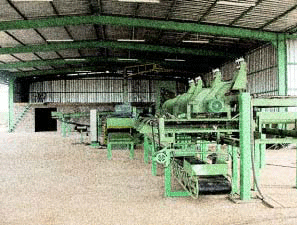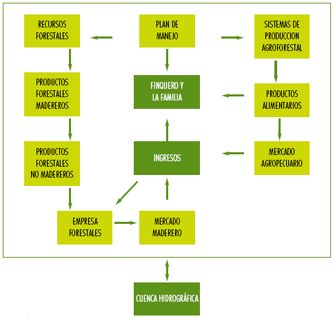Ecological forest farms, for their environmental regeneration of river basins
Forest Farms in practice
The ecological forest enterprise system, which was set up by a ministerial resolution, follows various stages of operation, based on the principle that the forest farmer’s tenancy of the land is tied to regular production. In return, farmers are given free use of an area of between 25 and 100 hectares, with or without a wood, including some hectares for agro-forestry production to satisfy family needs.
Then, a forestry management plan is drawn up, in line with the company’s overall management and organisation plans, and categorised accordingly (soil and water protection, production, etc.).
This management plan stipulates what work needs to be done over the forest farm’s production cycle (tree nursery, planting, maintenance, treatments, exploitation, fire prevention). For this work the farmer is given a basic monthly wage and yearly salary. Earnings can be supplemented, depending on results, by bonuses and sale of excess agro-forestry production. An important element is that forest companies guarantee decent housing and living conditions, as well as access to basic social services, for the farmers and their families.
Areas set aside for agro-forestry production must follow the basic principle of minimum ploughing and include permanent diversified agricultural products. This is achieved by planting fruit trees, preferably grafted, and taking simple measures to preserve and improve the soil that require low input and do not affect the environment, so as to satisfy food needs sustainably and promote excess production to increase family revenue. Similarly, in deforested areas, depending on reforestation conditions, the spaces between the trees in the first years of growth can be exploited agriculturally to help finance costs.
In the case of forest livestock systems for the production of cheap milk and meat, again the basic principle applies of utilising multipurpose forest plants to provide forage, shade and windbreaks. Trees that produce fruit for livestock feed should also be planted.
Duties, rights and prohibitions are established in forest farm regulations. Farmers can join trade associations, and have a right to breaks and holidays, protection and hygienic work conditions, and systematic improvements in living standards and the work environment. They also have a right to training, as part of the company’s capacity building programmes and those of other institutions concerned with the protection of the environment. Duties include implementation of management plans, safeguarding, promoting and protecting existing woodland, keeping and cleaning property and furniture. The most important prohibition stipulates that farm areas cannot be utilised by third parties.
Diagram showing how ecological forest farms work in river basin systems
DOWNLOAD THE BROCHURE PDF
english (1.2 MB)spanish (1.1 MB)








 COUNTRY OF ORIGIN
COUNTRY OF ORIGIN